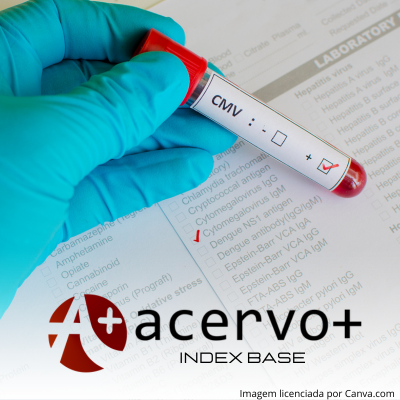Infecção por citomegalovírus como possível fator de proteção para esclerose múltipla
##plugins.themes.bootstrap3.article.main##
Resumo
Objetivo: Compreender se há uma associação da infecção por citomegalovírus e se pode ser um fator relevante de proteção no risco de esclerose múltipla. Métodos: Trata-se de uma revisão integrativa que explorou produções científicas difundidas em periódicos em bancos de dados do United States National Library of Medicine (PubMed), BVS e da Cochrane; foram aplicados critérios de inclusão e exclusão para a análise dos resultados e discussão. Descritores utilizados foram: “cytomegalovirus”, “multiple sclerosis”, “patients” com utilização do operador booleano “and”. Resultados: Este estudo se fez diante da análise de 21 estudos com objetivo de compreender se há uma associação e qual o papel do CMV na etiologia da EM. Os resultados foram apresentados no Quadro 1, facultando informações dos autores, ano de publicação, objetivo, e principais conclusões. Considerações finais: Fica evidente a necessidade de mais pesquisas que comprovem a associação da infecção do citomegalovírus ser um possível fator de proteção para EM.
##plugins.themes.bootstrap3.article.details##
Copyright © | Todos os direitos reservados.
A revista detém os direitos autorais exclusivos de publicação deste artigo nos termos da lei 9610/98.
Reprodução parcial
É livre o uso de partes do texto, figuras e questionário do artigo, sendo obrigatória a citação dos autores e revista.
Reprodução total
É expressamente proibida, devendo ser autorizada pela revista.
Referências
2. AUER M, et al. Correlation between anti-JC-virus and anti-cytomegalovirus, Epstein-Barr virus and –measles/rubella/varicella-zoster virus antibodies. 2017; 89(1): 3-9.
3. CLIFF JC. Cellular Immune Function in Myalgic Encephalomyelitis/Chronic Fatigue Syndrome (ME/CFS). 2019; 10: 796.
4. EFTHYMIOU G, et al. A compreensive analysis of antigen-specific antibody responses against human cytomegalovirus in patients with systemic scleroisis. Clin Immunol; 2019; 207: 87-96.
5. FROHMAN, E. et al., Multiple Sclerosis - The Plaque and the pathogenesis. N Engl J Med., [S.l.], 2006; 354: 942-55.
6. GRUT VM. Cytomegalovirus seropositivity is associated with reduced risk of multiple scleroise –a presymptomatic case-control study. Eur J. Neurol; 2021; 28(9): 3072-3079.
7. HALENIUS A, et al. Human cytomegalovirus and autoimmune disease. Biomed Res. Int; 2014; 472978.
8. HORAKOVA DJ, et al. Environmental factors associed with disease progression after the first demylinating event: results from the multi-center SET study. PloS One; 2013; 8(1): e 53996.
9. KARAMPOOR S, et al. Cytomegalovirus and varicella zoster virus seropositivity of Iranian patients with multiple scleroises: A population based study. J Neuroimmunol; 2017; 309: 4-6.
10. KUHLER J, et al. Conversion from clinically isolated syndrome to multiple scleroise: A large multicentre study. MultScler; 2015; 21(8): 1013-24.
11. MAKHANI NS, et al. Viral exposures and MS outcome in a prospective cohort of children with acquired de myelination. Multscler; 2016; 22(3): 385-8.
12. MAROU E, et al. Human Cytomegalovirus (HCMV) UL44 and UL57 specific antibody responses in anti-HCMV positive with systemic scleroises. ClinRheumtol; 2017; 36(4): 863-869.
13. MARTÍNES-RODRÍGUEZ J, et al. Adaptive natural killer cell responses to cytomegalovirus and disability progression in multiple scleroises. MultScler; 2016; 22(6): 741-52.
14. MOREIRA A, et al. Características adaptativas das células natural Killer na esclerose múltipla. Front Immunol; 2019; 10:2403.
15. MUNGER K, et al. Epstein-Barr and multiple sclerosis risk in the finnish maternity cohort. Ann Neurol; 2019; 86(3): 436-442.
16. NAJAFI S, et al. Prevalence of cytomegalovirus in patients with multiple sclerosis: A case-control study in Northern Iran. Jundishapur J Microbiol; 2016; 9(7): e36582.
17. SADAM H, et al. Identification of two highly antigenic epitope markes predicting multiple sclerosis in optic neuritis patients. EBioMEDICINE; 2021; 64:103211.
18. SALIM M, et al. Determining the IgM and IgG antibody titer against CMV and helicobacter pylori in the serum of multiple sclerosis patients comparing to the control group in Hamadan. Hum Antibodies; 2017; 26(1):23-28.
19. SUNDQVIST ET, et al. Cytomegalovirus seropositivity is negatively associed with multiple sclerosis. MultScle; 2014; 20(2): 165-73.
20. THAKOLWIBOON S, et al. Regional differences in the association of cytomegalovirus seropositivity and multiplr sclerosis: A systematic review and meta-analysis. MultScler Relat Disord; 2020; 45: 102393.
21. YUAN S, et al. An atlas on risk factors for multiple sclerosis: a mendelian randomization study. J Neurol., 2021; 268(1): 114-124.
22. ZAPPULO E, et al. Incidence and Predictive risk factors of infective events in patients with multiple sclerosis treated with agents targeting CS20 and CD52 surface antigens. Open Forum Infect Dis; 2019; 6(11): ofz444.

